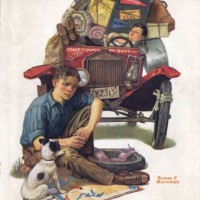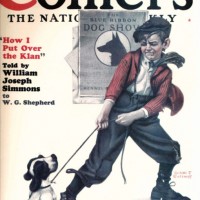History
Wistey
- Details
- Published on Thursday, 01 November 2012 08:20
- Written by Dr. Peter J. Couri
Peoria's Norman Rockwell
Frank Wistehuff was a talented Peoria upholsterer who worked for Schleicher & Son Furniture in the 1890s. He and his wife Bertha lived in a humble home at 722 Greenlawn St. In 1900, their only child, Revere, was born.
Little did they know then that he would become one of the most important commercial artists in American history.
Young Revere attended Blaine Grade School and then Manual Training High School in 1914. Friends described him as driven, hated to be turned down, walking too fast to be seen and always eating cheese.
He was a very talented musician. His instruments included the piccolo, flute, saxophone and clarinet. He played in all the youth bands and eventually the Peoria Municipal Band and Hoffman's Orchestra. To earn money during high school and college, he played for the silent pictures at the Apollo Theater.
But Revere Wistehuff's real passion was art and Manual enabled his talent to flourish when he became editor of the monthly school magazine, The Manhiscope, and the annual Manual yearbook. His illustrations and layouts were skillful beyond his young years and led to his vocation of illustrating national magazines and ads.
World War I was consuming the nation during his Manual years. Wistehuff wrote this goodbye poem to his friends departing for war:
"The time is nigh, Old Pal, when me must part
Our lives of fellowship at Manual High
To hit our new found trails of different goals
That need must part our happy friendship here.
But splitting friendships is a trifling thing
When men and nations stake their life blood, that
The world would be fit for LIVING once again."
The themes of patriotism and American pride would permeate all his art the rest of his life.
Revere started at Bradley Polytechnic Institute in 1918 where he applied himself to all the music and art department events. He made regular illustration contributions to the school newspapers and yearbooks. He said his Bradley years were the most glorious of his life and Bradley symbols and logos appeared in his art whenever his was illustrating with a college theme.
In 1919, he entered the Art Institute of Chicago. As his art talent for commercial illustration flourished, his professors encouraged him to enroll in the nations' top school, the Art Students League in New Rochelle, N.Y. This hub of the nation's best commercial illustrators filled the need for thousands of national magazines and ads that used original art.
Revere Wistehuff soon became known as "Wistey." He remained life long friends with the Leyendecker brothers, Leslie Thatcher, James Montgomery Flagg, Edward Penfield, Orson Lowell, Walter Beach Humphrey and especially Norman Rockwell.
Living down the road from Rockwell, Revere was frequently asked to help "fill-in" Rockwell paintings to keep his busy schedule flowing. Rockwell liked the way Wistehuff painted faces.
Like Rockwell, Wistehuff styled himself as a "realist." He worked with models for all his pictures. He said he was not a "gallery man" and did not paint to exhibit. All his work was commercial.
He would be surprised to learn that in the 21st century, his original art sells for many thousands of dollars.
In the 1920s through the 1940s, Wistehuff's lively and beautiful scenes of American life graced the covers of hundreds of magazines, notably the Saturday Evening Post, Life Magazine, Colliers, Liberty, Wit, The Wireless Age, Everybody's Weekly, Capper's Farmer, American Girl, People's Popular Monthly, Canada's MacLeans, New York Herald Tribune, People's Home Journal and American Needlewoman to name a few.
He drew illustrations for many ad campaigns, most notably John Hancock Mutual Life Insurance, Gulf Oil, Western Union and Beck Beer.
In the 1950s and 60s, he was a major contributor to the World Book Encyclopedia Corporation and their many educational endeavors. His illustrated children's textbooks are still very popular and reprinted to this day.
Wistehuff resided in New Rochelle the rest of his life. He never married. His life revolved around the high society social events of New Rochelle and he lived in the Guion Place Mansion with Judge & Mrs. Bizel.
He visited Peoria every summer of his life and frequently joined in with the Peoria Municipal Band. He still has many relatives in Manito, Pekin and Washington.
He died in 1972.



























































